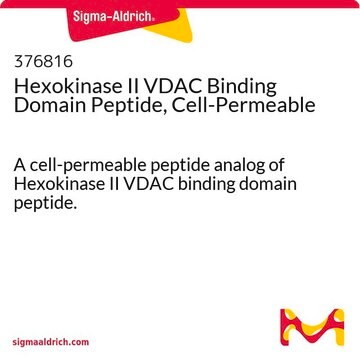197217
Bcl-xL BH44₋23, Human, Cell-Permeable
A cell-permeable peptide that prevents apoptotic cell death by directly binding to the voltage-dependent anion channel (VDAC) and blocking its activity.
Sinonimo/i:
Bcl-xL BH44₋23, Human, Cell-Permeable, HIV-TAT₄₈₋₅₇-β-Ala-Bcl-x L BH4₄₋₂₃, Ac-GRKKRRQRRR-βA-SNRELVVDFLSYKLSQKGYS-OH
About This Item
Prodotti consigliati
Livello qualitativo
Saggio
≥95% (HPLC)
Forma fisica
lyophilized
Produttore/marchio commerciale
Calbiochem®
Condizioni di stoccaggio
OK to freeze
desiccated (hygroscopic)
Solubilità
20% acetic acid: 5 mg/mL
DMSO: 5 mg/mL
Condizioni di spedizione
ambient
Temperatura di conservazione
−20°C
Descrizione generale
Azioni biochim/fisiol
Voltage-dependent anion channel (VDAC)
Confezionamento
Attenzione
Sequenza
Stato fisico
Ricostituzione
Altre note
Futaki, S., et al. 2001. J. Biol. Chem.276, 5836.
Shimizu, S., et al. 2000. Proc. Natl. Acad. Sci. USA97, 3100.
Note legali
Codice della classe di stoccaggio
11 - Combustible Solids
Classe di pericolosità dell'acqua (WGK)
WGK 1
Punto d’infiammabilità (°F)
Not applicable
Punto d’infiammabilità (°C)
Not applicable
Certificati d'analisi (COA)
Cerca il Certificati d'analisi (COA) digitando il numero di lotto/batch corrispondente. I numeri di lotto o di batch sono stampati sull'etichetta dei prodotti dopo la parola ‘Lotto’ o ‘Batch’.
Possiedi già questo prodotto?
I documenti relativi ai prodotti acquistati recentemente sono disponibili nell’Archivio dei documenti.
Il team dei nostri ricercatori vanta grande esperienza in tutte le aree della ricerca quali Life Science, scienza dei materiali, sintesi chimica, cromatografia, discipline analitiche, ecc..
Contatta l'Assistenza Tecnica.








